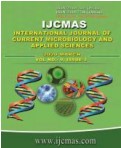


 National Academy of Agricultural Sciences (NAAS)
National Academy of Agricultural Sciences (NAAS)

|
PRINT ISSN : 2319-7692
Online ISSN : 2319-7706 Issues : 12 per year Publisher : Excellent Publishers Email : editorijcmas@gmail.com / submit@ijcmas.com Editor-in-chief: Dr.M.Prakash Index Copernicus ICV 2018: 95.39 NAAS RATING 2020: 5.38 |
Ten camels showing typical clinical lesions of itching, pruritus, biting and rubbing against objects, alopecia, erythema, keratinization, thickening, corrugations and wrinkling of the skin, exudation and bleeding, fissured skin and scab formation were identified. The skin scrapings were collected from the edges of skin lesions in clean small size plastic jars separately, each duly marked for identification of the individual animal. Sarcoptes scabiei var cameli mites were identified on the basis of their characteristic morphological features. Blood from these camels was collected for Hemato-biochemical analysis at the start of each treatment to find out the effect of mange infestation on the blood physiology of animals. The results reveal that Hb, PCV, TEC showed a decreasing trend than the normal range indicative of anemia in the diseased animals. Among the biochemical parameters, Total Protein, Albumin, Globulin was decreased. TLC, Neutrophils, Eosinophils, Lymphocytes, Basophils, Monocytes and AST, ALT, ALKP, LDH, Bilirubin, BUN was increased. Treatment trial was started by dividing the ten camels into threegroups. On Group 1, 40 % concentration of Azadirachta indica was applied, on Group 2, Cypermethrin was applied, on Group 3, 40 % concentration of Azadirachta indica was applied and additionally Injection Ivermectin and Injection Vetade were also given. After some days again blood samples were taken for Hemato-biochemical analysis which showed a satisfactory response in all the groups. The treatment given to the Group 3 was best among the three therapeutic trial groups.
 |
 |
 |
 |
 |